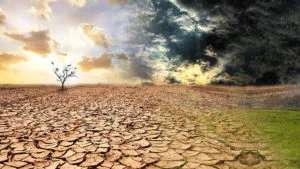Artificial Intelligence is one of the most trending fields of computer science globally, relating to intelligent machines, robots, and numerous computer programs that act like humans. On the other hand, Earth’s climate change is one of the most complex issues that the generation is facing. The weather patterns are changing, threatening- food production, shrinking ice sheets, declining the Arctic Sea ice, causing sea levels to rise, etc. These events will eventually result in catastrophic flooding if not controlled.

The good news for the earth- artificial intelligence has brilliant tools helping in slow or reversal of global warming. Climate change is the biggest challenge; the planet is facing. A possible solution, including technology like artificial intelligence (AI), is a must. One such biggest name in AI research has laid out a road map suggesting how machine learning can help to tackle climate change.
The report ‘Tackling Climate Change with Machine Learning’ covers possible machine-learning interventions in 13 domains, from electrical systems to farms, forests to climate prediction. Some ‘high-leverage’ recommendations are mentioned below from the report:
- Improvement predictions of how much electricity is needed: If we rely on renewable energy sources, utilities will need a better way of predicting how much energy is needed in real-time for an extended period. Some algorithms already exist that forecast the energy demand, but efforts to make algorithms more explainable could also help operators interpret their outputs and use them in scheduling.
- Discover new materials: New materials are needed to be developed that harvest, store and use energy efficiently, but the process of discovering new materials is typically slow and tedious. Machine learning is set to accelerate things by finding, designing, and evaluating new chemical structures with the desired properties. The latter materials can one day replace steel and cement, accounting for 10% of all global greenhouse gas emissions.
- Lower barriers to electric-vehicle adoption: Electric vehicles, an essential strategy for decarbonizing transportation, face several adoption challenges where machine learning can help. Algorithms will be able to improve battery energy management to increase the mileage of each charge and reduce ‘range anxiety.’
- Help in making buildings more efficient: Innovative techniques with intelligent control systems will dramatically reduce a building’s energy consumption by taking weather forecasts, occupancy, and environmental conditions into account to adjust heating, cooling, ventilation, lighting for an indoor space. A smart building can also communicate directly with the grid to reduce how much power it is using.
- Optimizing supply chains: Similarly, machine learning can optimize shipping routes, minimize inefficiencies, and carbon emissions in the supply chains of food, fashion, and consumer goods industries. Supply-demand should reduce production and transportation waste for low-carbon products encouraging more environmentally friendly consumption.
- Improve deforestation tracking: Deforestation contributes to roughly 10% of global greenhouse-gas emissions, but tracking and preventing it is usually a complicated process. Satellite imagery & computer vision can automatically analyze the loss of tree cover in a particular location at a much larger scale combined with algorithms.
- Nudge consumers to change how we shop: Ads have successfully used for targeting consumers for behaving in more environmentally aware ways.
Machine learning and AI, like any other technology, does not always make the world a better place- but it can. In the fight against climate change, it will have a significant contribution offering to access domain areas. Machine learning can optimize system efficiency, accelerate the processes of discoveries, accelerate computationally expensive simulations through hybrid modeling.
Application of machine learning to tackle climate change has the potential and benefit of society. Solving any problem hence takes time, AI and machine learning are not the ultimate options. It took 40 years for scientists to understand whether climate change is a real problem or no. AI is continuously evolving with time, and experts are trying to solve environmental issues using machine learning.
To know more about Architecture Technology, Stay Tuned.



